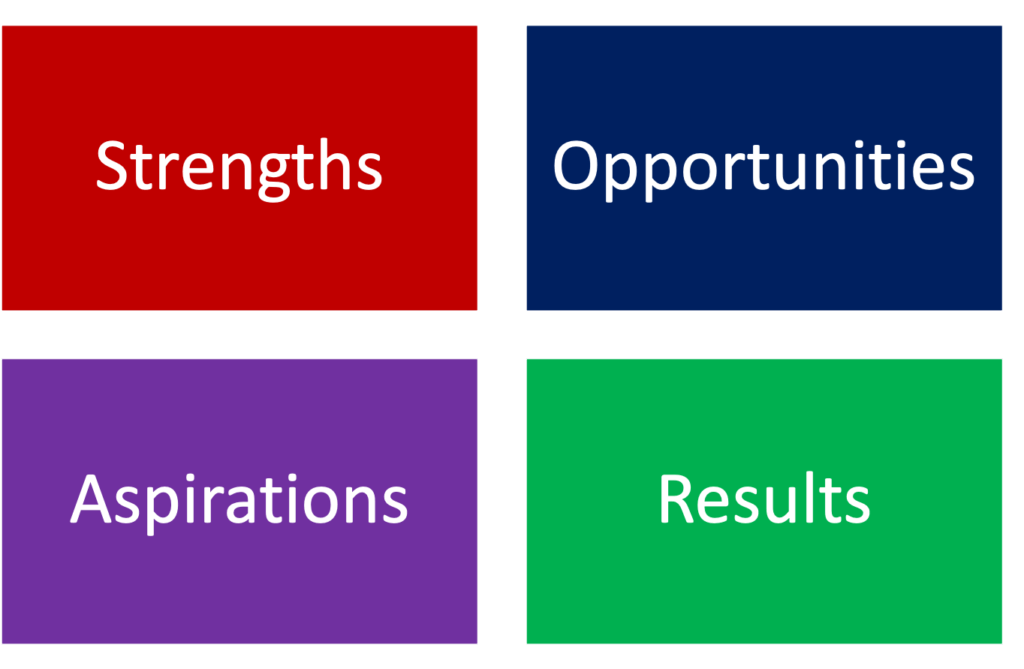Subscribe to Our FREE Strategic Analysis Newsletter Today!
The free strategic analysis newsletter keeps me up-to-date in my field as a manager.

Mei Lang
Business Strategist
Free Offer Expires in:
Minutes
Seconds
What is The SOAR Analysis Framework?

Strengths: Identifies the core competencies, assets, resources, and accomplishments of an organization.
Opportunities: Situational awareness of the external environment that can lead to increased profits, growth by meeting customer needs, or weaknesses or threats that can be reframed into favorable possibilities.
Aspirations: Considers what the organization is versus what it can be; what the organization should be known for and reason for existence now and into the future.
Results: The real, tangible, and measurable conditions that indicate achievement of goals, objectives, and aspirations.
The SOAR Analysis Framework is a great planning tool that can provide meaningful and clear strategic direction. Business strategists utilize the Strengths, Opportunities, Aspirations, and Results (SOAR) Analysis Framework as a business intelligence tool to understand the core competencies of an organization or its competitors. Created by Michael Porter, the SOAR Analysis Framework appraises the internal and external environment of a company, aiding in the strategic planning process. The results of a SOAR Analysis establish a basis for long-term strategic planning to carryout the vision of a company with a focus on building competitive advantage. The SOAR Analysis Framework can also aid in the contingency planning process, considering alternative strategies and business models to counter risk. In summary, the SOAR Analysis Framework is a strategic planning tool that employs an “Appreciative Inquiry” methodology to: 1) evaluate the internal environment of a company, 2) evaluate the external environment of a company, 3) evaluate the competition (competitive analysis), and/or to mitigate risk through contingency planning.
Strategic analysis is an important step in the strategy planning process. One form of strategic analysis is known as the Strengths, Opportunities, Aspirations, and Results (SOAR) Analysis Framework. The SOAR Analysis Framework is a highly practical tool that employs an appreciative inquiry methodology to assess the fundamental state of a business for the purpose of developing business strategies with a focus on growth, change, and/or improvements internal or external to the business. Approaching the analysis from a positive perspective, a Strategist uses the SOAR framework to evaluate and gain insights into organizational strengths that can lead to the realization of opportunities. After assessing the opportunities, the strategist will form attainable aspirations, along with a plan of action to achieve desirable results. The positive focus on strengths provides strategists and participants in the SOAR analysis process to have meaningful, results and solutions oriented conversations with an emphasis on overall organizational success.
Strategists have a plethora of uses for the SOAR Analysis Framework. Most commonly strategists use the SOAR analysis tool to:
- Formulate or update a Vision Statement
- Prepare or revise a Mission Statement
- Align strategic initiatives with Organizational Values
- Develop a plan to achieve Goals and Objectives
- Determine Measurable Results for a strategy
- Develop and Implement Action Plans to execute strategies
- Identify growth or expansion opportunities
- Realize core competencies, capabilities, resources, or assets
What is the Difference Between a SOAR and SWOT Analysis?
The SOAR Analysis is a relatively new, and more positive asset oriented technique that has become a viable alternative to the infamous SWOT analysis. It focuses the analysis using a positive lens to look at various aspects of an organization to aid in development. In essence, the SOAR analysis leverages an organizations strengths and opportunities to develop viable aspirations and measurable results.
A strategic analysis tool, the SOAR analysis helps strategists to evaluate and focus on the core competencies (strengths) and future-oriented vision of an organization that can be achieved through the measurement of goals and objectives using an appreciative inquiry approach. These strengths are distinctive competitive advantages that set the organization apart from any other organization that may be direct or indirect competition. Strengths consist of the capabilities, resources, or assets of an organization that enables or results in competitive advantage. From an appreciative inquiry perspective, the strategist is identifying all positive attributes related to the organization, including accomplishments over time. This differs from the SWOT analysis based on the competitive lens a strategist uses to determine the strengths. The competitive lens is largely focussed on performance, such as efficiency and effectiveness related competencies, resources, or assets that enable the organization to outperform its competition.

Weaknesses are of no concern in a SOAR Analysis because of the appreciative inquiry lens being applied. As indicated in the diagram above, there is a difference between opportunities realized in a SOAR analysis versus opportunities to capitalize on competitor weaknesses or blind spots as typically sought in a SWOT analysis. In the SOAR Analysis Framework, there is an important focus on determination of aspirations that align with the vision and mission of the organization. Aspirations help a strategist to realize stretch goals and objectives in the strategic planning process. Determination of aspirations requires brainstorming. It is an abstract critical thinking process much like the “Future Thinking” process. Quite literally, the main purpose of determining aspirations is to imagine any and all possibilities that the organization can realize (based on its strengths) that can transform the organization into a huge success.
Threats are of no concern in a SOAR analysis because of the appreciative inquiry lens being applied throughout the process. In a SWOT analysis, threats are important to identify in order to mitigate risks the organization may face when seeking opportunities, or in general. Threats are important to recognize, but in a SOAR analysis, the goal is to identify opportunities and aspirations without having to worry about limitations or risks.
Learn More About SOAR Analysis
Why is a SOAR Analysis useful?
A SOAR Analysis is a powerful tool for uniting stakeholders in order to recognise the organisation’s potential and create a shared vision
Who Conducts a SOAR Analysis?
Add Your Heading Text Here It works for everyone within an organisation, irrespective of position or hierarchical level. It can also
© soaranalysis.com
All Rights Reserved 2021

